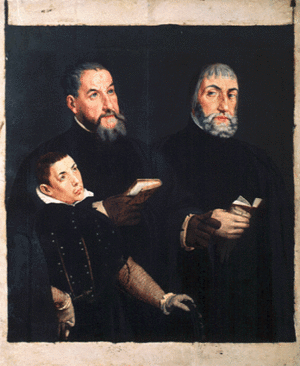Diego Caballero facts for kids
Diego Caballero (who died in 1560) was a Spanish businessman. He was also a minor Conquistador in the Caribbean region and near the coast of Venezuela. He became very rich in America. He used his wealth to start many businesses across the Spanish Empire.
Diego Caballero became one of the most important Spanish merchants of his time. He also held several important jobs working for the King, Charles V, and in the city of Seville.
Contents
Early Life and New Beginnings
Diego Caballero was born in Guadalupe, Spain, in the late 1400s. His parents were Pedro Caballero and Catalina de Villegas.
In March 1517, he moved to Santo Domingo with his brother Alonso. His cousin, Hernando Caballero, was the Mayor of Santo Domingo. This helped Diego get permission to move there.
Because of his family connections, Diego was appointed to several official jobs on the island. He quickly joined the Royal Audiencia of Santo Domingo. This was the first Royal Court of Justice there.
His business and political power grew along the coast of Tierra Firma. This area stretched from Santa Marta to the island of Trinidad. He was put in charge of the money for Hispaniola and became its military governor. He also ran many private businesses there.
After some time, Diego Caballero left his official jobs. He decided to focus completely on shipping and trade. He managed businesses on both sides of the Atlantic Ocean.
Early Activities in the Americas
Diego Caballero received permission to gather a fleet of ships. He used these ships to capture native people along the coast of Venezuela. This area was between Cabo de San Román and Cabo de la Vela, and on nearby islands. This was done under the supervision of a judge from the Royal Court.
At that time, some people tried to justify this by saying the native people refused to become Christians. However, laws soon came into effect that made such actions illegal. These were called the Laws of the Indies.
After about a year, Diego Caballero stopped these activities. This might have been because of the new laws or a change of heart. He stopped chasing native people and taking their belongings on the Venezuelan coast.
Around this time, other Spanish leaders worked to protect and help native people. They wanted to teach them Christianity and a more "organized way of life."
Becoming a Ship-Owner and Merchant
After his early activities, Caballero began to manage pearl fisheries. He also bought four ships. He sent his brother Alonso to Seville to be his business agent there.
Diego started sending valuable wood, metals, and pearls to Seville. These precious materials were found in places like Cubagua and Isla Margarita in the Caribbean. In return, his ships brought back textiles, tools, and other useful goods from Spain.
As his businesses grew, he needed trustworthy people to manage his many ventures. This included the many voyages of his ships. He hired many people from his home country, including his nephew, Francisco Caballero. He put Francisco in charge of the pearl fisheries at Cabo de la Vela.
By August 1525, Diego was happy with how his businesses were run by friends and family. He then signed an agreement with King Charles V, Holy Roman Emperor (Charles I of Spain). This agreement allowed him to explore the area of the Venezuela Province. This land stretched from Cabo de San Román to Cabo de la Vela.
Wealthy banking families, like the Fuggers and the Welsers, learned about his successful businesses. They managed to prevent him from becoming the Governor of Venezuela.
Despite this setback, Diego made his fleet of ships even bigger. He opened more trade routes by sea and started new pearl fisheries. These were in Cubagua, Cabo de la Vela, and Panama.
The Church asked for better treatment of the native pearl divers. Diego, as a "good Christian," ordered that his divers should attend Mass before diving. He also encouraged them to marry local women. This was meant to make them safer and help increase the number of divers. He also ordered that his divers receive better food, a small amount of wine each day, shirts, shorts, shoes, and hammocks or straw beds. This was to ensure they were comfortable and had everything they needed.
Return to Spain
In 1535, Diego Caballero moved back to Spain for good. He settled in Seville. He showed his great wealth by buying a position on the City Council, becoming a Veintiquatro.
He continued to trade with the Americas. He also expanded his businesses into wine, oil, textiles, and other goods. He traded across Spain and its empire, including Flanders.
Later Years and Retirement
When he became old, Diego decided to retire from business. He used the large profits he had made to live comfortably in Seville. There, he focused on charity and good deeds.
Every year, he visited the Sanctuary of Guadalupe in Extremadura. He did this to thank the Virgin Mary for her help. He also prayed for his family and for his own soul.
Diego Caballero passed away on November 27, 1560. He died peacefully in Seville, having brought prosperity to the city.
See also
 In Spanish: Diego Caballero para niños
In Spanish: Diego Caballero para niños


